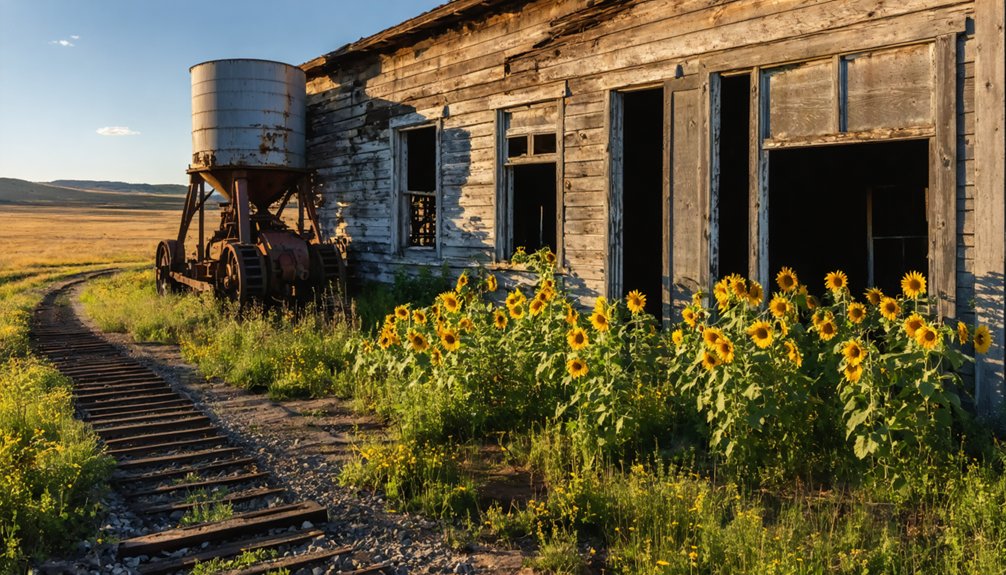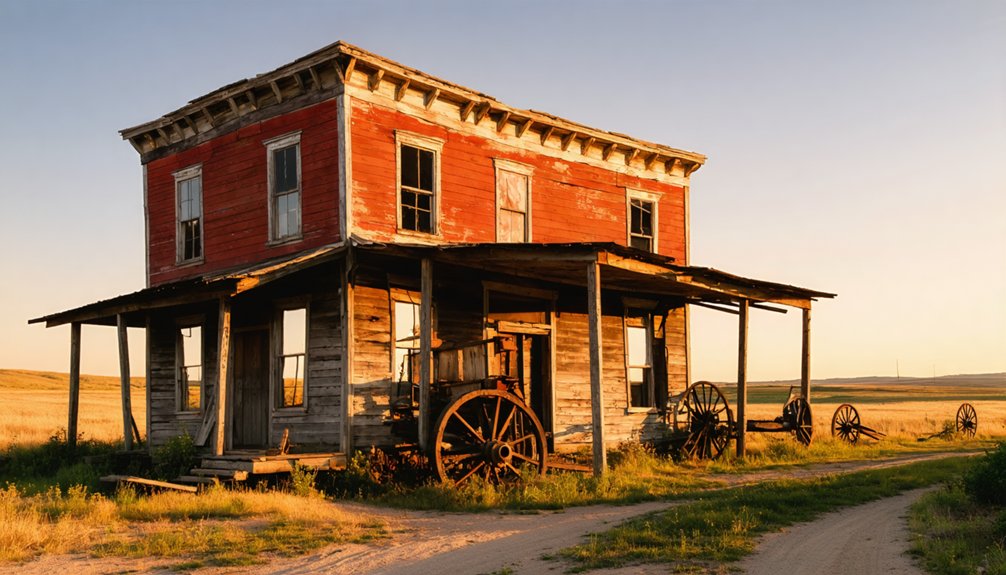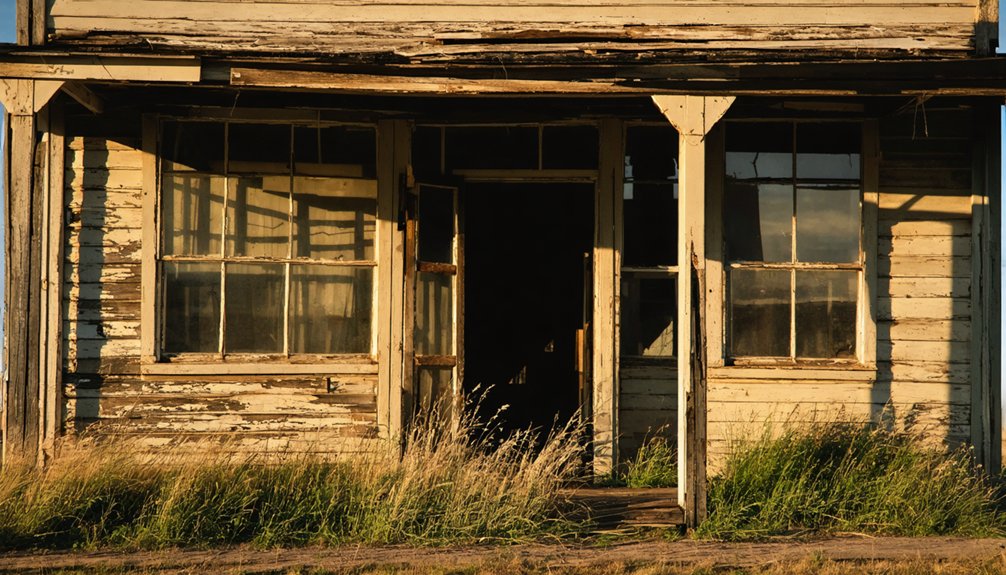You’ll find Forest City’s story nestled in South Dakota’s Black Hills, where gold mining dreams birthed a thriving community in 1911. This Pennington County settlement flourished with miners earning up to $75 daily, while women ran boarding houses and shops around the bustling commercial core. By 1962, the town vanished beneath Lake Oahe’s waters during the Oahe Dam construction. The submerged ruins hold tales of frontier resilience and mining innovation that shaped the region’s destiny.
Key Takeaways
- Forest City was established in 1911 as a gold mining town in Pennington County, South Dakota, at an elevation of 5,400 feet.
- The town thrived during the gold rush era with miners earning $50-$75 daily, supporting local businesses and creating a diverse community.
- Economic decline occurred when gold production rates dropped, causing mass exodus of workers and eventual abandonment of the town.
- Forest City became completely submerged under Lake Oahe in 1962 following the construction of the Oahe Dam in 1948.
- The sunken ghost town now contributes to regional tourism and serves as a testament to South Dakota’s mining heritage.
The Rise of a Black Hills Mining Town
While many Black Hills mining towns emerged during the late 1800s gold rush, Forest City’s story began in 1911 with the discovery of its namesake mine in Pennington County, South Dakota.
Like the Homestake claim discovery of 1876, this area proved to be a valuable mining location.
You’ll find this rugged settlement perched at 5,400 feet elevation, where early miners tackled the challenging terrain with determination and innovative mining technology of their day.
The town’s strategic location near Hill City proved vital for its development, as trade routes and communication lines helped sustain the growing community.
As mining operations expanded, Forest City’s population swelled with fortune seekers drawn to the promise of gold in the hard rock deposits.
Local community folklore tells of the miners’ struggles with refractory ore, which required specialized crushing and chemical treatment processes to extract the precious metal from stubborn rock formations.
The town’s development paralleled earlier settlements where placer gold deposits had sparked rapid growth and development across the region.
Life During the Gold Rush Era
As prospectors flocked to Forest City during the gold rush, they encountered a harsh life defined by backbreaking labor and constant danger. You’d find yourself wading through icy streams during placer mining or risking cave-ins in deep shaft operations.
Mining hazards were everywhere – from toxic mercury exposure to deadly explosions from newly introduced machinery. A typical miner could earn $50 to $75 daily through intense physical work. The discovery by Colonel George Custer in 1874 had triggered this dangerous rush for riches.
The town’s social fabric reflected the era’s tensions. You’d witness cultural conflicts as Native Americans defended their sacred land while miners and settlers pushed deeper into treaty territory.
Despite the challenges, a diverse community emerged. Women ran boarding houses and shops while men prospected.
At night, you could find comfort in the saloons, sharing stories with fellow miners from Europe, Asia, and across America, all seeking their fortune in this unforgiving landscape.
Economic Boom and Daily Activities
During Forest City’s heyday, the gold mining industry served as the economic backbone that transformed a frontier outpost into a bustling commercial hub.
Gold transformed Forest City from a rugged outpost into a thriving commercial center during its prosperous mining era.
You’d have found miners working long shifts in the mines while local businesses, from general stores to equipment suppliers, fueled the town’s economic growth.
The community’s resilience showed in how they balanced hard work with rich social lives.
When you weren’t in the mines, you could join community gatherings, attend church functions, or enjoy outdoor activities like hunting and fishing.
Mining companies often provided essential services, including healthcare and education, while technological advances kept operations efficient.
Despite challenges from weather conditions and market fluctuations, the town maintained its liveliness through strong local governance and a commitment to infrastructure development.
The ten-stamp mill enhanced the town’s mining capabilities, allowing for more efficient ore processing and increased production.
The introduction of the electro-cyanide process in local mills revolutionized how ore was processed and refined in the area.
Social Structure and Community Development
You’ll find Forest City’s social fabric was woven through its key institutions, including a town council that managed local affairs and coordinated with mine owners who held considerable sway in community decisions.
The town’s religious life centered around a prefabricated church building that arrived by rail, while its schoolhouse served both educational needs and as a gathering place for civic functions. Much like in Capa, the town had a local hotel that provided lodging for visitors and travelers. The community saw major improvements after the revenue of $114,742 in 1927 helped fund various building projects.
The general store and saloon emerged as crucial social hubs where miners, merchants, and families would gather to exchange news and maintain community bonds, reflecting the town’s efforts to establish permanence despite its economic uncertainties.
Community Leadership and Government
While records of Forest City’s formal governance structure remain sparse, historical evidence suggests the town operated under an informal leadership system typical of small South Dakota settlements.
You’ll find that community governance often centered around respected local figures who emerged naturally as decision-makers, rather than through official appointments.
Like many small frontier communities, Forest City relied on informal leadership networks where residents would gather to address common concerns and make collective decisions.
The town’s development followed patterns seen in other settlements, where railroad companies played a major role in establishing and shaping the community’s growth.
You can imagine townspeople meeting in local establishments or homes to discuss matters affecting their daily lives, similar to how the mining communities evolved when placer miners arrived in the region in 1875.
This system of community-driven governance reflected the independent spirit of South Dakota’s early settlers, who valued direct participation in local affairs over rigid governmental structures.
Religious and Educational Institutions
Despite extensive research into Forest City’s social fabric, records reveal a notable absence of formal religious and educational institutions within the settlement.
You’ll find that religious practices likely took place in homes or makeshift community spaces, following the pattern of many frontier settlements where formal church buildings weren’t established.
Educational opportunities were similarly limited. While nearby ghost towns often maintained one-room schoolhouses, there’s no evidence of a dedicated school in Forest City.
Your ancestors might’ve educated their children at home or sent them to neighboring communities for schooling. The town’s focus on its sawmill operations, rather than developing permanent institutions, suggests that community life centered more on economic survival than establishing formal social structures.
When the sawmill closed in 1952, any remaining institutional framework likely dissolved with the town’s abandonment.
Social Gathering Places
The social fabric of Forest City revolved around several key gathering places that shaped daily life in this lumber town.
You’d find residents congregating at the bustling town hall for community events and local governance, while the saloons served as vibrant social hubs where workers and locals mingled after long shifts at the sawmill.
The general store wasn’t just a place to buy goods – it was where you’d catch up on the latest news and participate in social rituals that kept the community connected.
The railroad depot buzzed with activity as travelers and townspeople crossed paths, while seasonal markets and gatherings strengthened neighborhood bonds.
Until the sawmill’s closure in 1952, these gathering spots fostered a tight-knit community where daily interactions built lasting relationships among Forest City’s residents.
The Architecture and Layout of Forest City
As you explore Forest City’s architectural remains, you’ll notice the predominant use of local timber in simple rectangular structures that once lined the town’s informal, terrain-following streets.
The buildings’ placement reveals a practical town layout that clustered homes and businesses near mining operations while maintaining enough separation to buffer noise, with wooden structures featuring stone foundations in key commercial areas.
The mining infrastructure, from processing plants to equipment foundations, formed the industrial backbone of the settlement, while modest wooden homes and basic community buildings like churches and schools served the social needs of the mining community.
Building Materials and Styles
While most frontier towns of the late 19th century featured elaborate architectural designs, Forest City’s buildings embodied a more practical approach focused on functionality and durability.
You’d have found simple wooden structures dominating the landscape, with metal roofing protecting against South Dakota’s harsh weather conditions.
The building materials were primarily sourced locally, reflecting the frontier spirit of self-reliance. You would’ve noticed the rustic charm of these structures, built without fancy ornamentation but crafted to last.
The architectural styles followed a no-frills frontier approach, with buildings adapted to the natural terrain. Local craftsmen influenced the designs, creating structures that served the community’s needs while working with readily available resources.
Today, these architectural remnants rest beneath Lake Oahe’s waters, preserved only in historical records.
Town Planning Features
Despite its relatively brief existence, Forest City’s layout followed a thoughtful design that you’d recognize in many Black Hills mining settlements. The town’s spatial organization adapted naturally to the rugged terrain, with buildings clustered strategically near mining operations while maintaining safe distances from industrial hazards.
You’ll find the town layout reflected common mining settlement patterns:
- A compact commercial core featuring essential services like the general store, saloon, and post office
- Residential zones spreading outward from the center, with dwellings positioned for ideal sunlight and weather protection
- Industrial areas concentrated near mine shafts, with space for ore processing and equipment storage
Roads and trails connected key areas within Forest City while linking to neighboring settlements and crucial resources, creating an efficient network that served both mining operations and daily life.
Infrastructure and Construction Methods
Since materials shaped Forest City’s architectural identity, you’ll find that locally sourced timber dominated the town’s construction landscape.
You’d see simple log buildings with notched corners and wooden shingles, reflecting the practical mindset of frontier construction techniques.
Infrastructure development centered on mining operations, with wooden hoists and headframes dotting the landscape.
You’d notice how builders used hand tools to quickly erect structures, prioritizing function over form.
The town’s mining infrastructure included basic water management systems and dirt roads connecting work sites.
When the railroad arrived, simple wooden trestles facilitated ore transport.
Buildings clustered near mine shafts and water sources, with commercial structures sporting false fronts along main streets.
Residential areas grew organically in parallel rows, creating an informal but functional layout shaped by the terrain’s natural contours.
Transportation and Trade Routes
As the Missouri River’s steamboat traffic began to wane in the late 1800s, Forest City’s transportation network underwent a significant change with the arrival of the Forest City and Gettysburg Railroad in 1890.
This 19-mile rail line revolutionized agricultural transport, connecting you to broader markets and the Chicago & North Western Railway at Gettysburg.
- The railroad’s impact extended beyond mere freight, serving as your essential link for mail, telegrams, and daily necessities.
- You’d find the depot bustling as a social hub, where locals gathered to ship goods and exchange news.
- Your grain elevators and warehouses along the tracks facilitated the region’s agricultural commerce.
Though the railroad’s success was short-lived, abandoning operations by 1911, it represented an important chapter in Forest City’s shift from river to rail transportation.
The Decline of Mining Operations

You’ll find that Forest City’s mining operations declined sharply as gold production rates dwindled and extraction became economically unfeasible, leading to the permanent closure of the mine.
The workforce steadily abandoned the mining town as jobs disappeared, with miners seeking opportunities elsewhere in more promising locations.
The closure’s financial impact rippled through the community, effectively ending Forest City’s role as a mining center and setting the stage for its transformation into a ghost town.
Dwindling Gold Production Rates
While Forest City’s early mining operations showed promise, the mine’s gold production rates steadily declined due to mounting geological and technological challenges.
You’ll find that gold extraction became increasingly difficult as miners encountered complex ore bodies trapped in hard rock formations, requiring more sophisticated mining technology than what was available.
- Ore quality deteriorated over time, with gold deposits becoming more refractory and harder to process.
- Primitive extraction methods and limited underground access restricted mining depth to just 50 meters.
- Competition from larger operations like the Homestake Mine drew away vital investment capital.
The combination of declining ore grades, technological limitations, and economic pressures made it increasingly challenging to maintain profitable gold production levels.
Even innovations like cyanide processing couldn’t offset the mounting costs and diminishing returns that ultimately led to reduced output.
Workers Leaving Mining Town
The mass exodus of Forest City’s mining workforce began in earnest during the early to mid-20th century when dwindling ore yields and aging infrastructure forced major operational cutbacks.
You’ll find that worker migration accelerated as the 165-foot shaft closed and mining operations shifted toward mechanization, requiring fewer laborers. Families packed up and left en masse, following breadwinners to more promising mining districts or different industries altogether.
The mining decline triggered a domino effect – as workers departed, local businesses shuttered, schools closed, and community gatherings dwindled. Housing sat vacant while infrastructure deteriorated from lack of municipal funding.
Safety concerns about unstable shafts and poor ventilation, coupled with sporadic employment opportunities, pushed even more workers to seek stability elsewhere. Few ever returned, as they’d established new lives in communities offering sustainable alternatives.
Financial Impact of Closure
As Forest City’s mining operations ground to a halt, the economic ripple effects devastated the region’s financial stability.
You’d have witnessed a stark transformation as the once-thriving mining economy collapsed, presenting unprecedented economic challenges for local families and businesses.
- Mining revenue streams dried up completely, from direct ore sales to supporting industries like equipment suppliers and transport services.
- Local government coffers took a severe hit with the loss of mining taxes, permits, and fees.
- Property values plummeted as the economic foundation crumbled, leaving many residents facing difficult choices.
Despite these setbacks, the story of Forest City reflects the broader community resilience of mining towns across the Black Hills.
While the gold and mineral wealth may have vanished, the town’s legacy endures as a symbol of the region’s rich mining heritage.
Submergence Beneath Lake Oahe

Once construction of the Oahe Dam began in 1948, Forest City‘s fate was sealed beneath the rising waters of what would become Lake Oahe. By 1962, you’d find the town completely submerged about 9 miles west of Gettysburg, South Dakota, now resting under one of America’s largest reservoirs.
The dam’s completion didn’t just erase a town; it transformed over 200,000 acres of Native American lands on the Standing Rock and Cheyenne River Reservations. This submerged history includes sacred burial grounds and cultural sites that you can’t recover.
While the 231-mile lake now draws 1.5 million visitors annually for recreation, it represents a profound loss for displaced communities. Beneath these waters that stretch from Pierre to Bismarck, you’ll find more than just a ghost town – you’ll find the cultural implications of progress at any cost.
Legacy and Historical Significance
While many ghost towns fade into obscurity, Forest City’s legacy endures as a poignant reminder of South Dakota’s complex relationship with progress and preservation.
Like hundreds of other Black Hills communities, it represents a vital chapter in the region’s cultural heritage, offering you a glimpse into the boom-and-bust cycle that shaped the area’s identity.
- The town’s remains contribute to the broader narrative of ghost town tourism in the Black Hills, drawing history enthusiasts and adventure seekers.
- Its story exemplifies the delicate balance between resource extraction and community sustainability that many mining towns faced.
- You’ll find that Forest City’s legacy lives on through preserved historical markers and local folklore, joining over 400 other ghost towns in telling the tale of South Dakota’s mining era.
Preservation of Mining Town Heritage

Despite the challenges of preserving South Dakota’s mining heritage, dedicated conservation efforts have transformed many historic structures into living monuments. At Forest City, you’ll find ghost town preservation initiatives that protect remaining buildings under National Forest oversight, safeguarding these tangible links to the past.
Through mining heritage initiatives, you can explore documented mining claims and historical records that tell the story of daily life in these frontier communities.
You’ll discover interpretive trails and informational plaques that bring the town’s mining history to life. Local museums display artifacts and photographs while maintaining thorough archives of the area’s mining culture.
Frequently Asked Questions
What Happened to the Cemetery When Forest City Was Flooded?
You’ll find the cemetery faced severe flood impact when Lake Oahe submerged it, with limited cemetery preservation efforts. Many graves weren’t relocated and now rest beneath the reservoir’s waters.
Were Any Artifacts or Valuables Recovered Before the Town’s Submergence?
Like many of the 300+ submerged towns across America, you won’t find records of organized artifact discoveries before Forest City’s flooding. No valuable relics were officially salvaged before Lake Oahe claimed the town.
Did Any Original Forest City Residents Relocate Together to Another Community?
You won’t find evidence of organized relocation patterns where residents moved together. Based on historical records, community ties dispersed as individuals independently sought opportunities elsewhere after the town’s decline.
What Was the Maximum Recorded Depth of Gold Mining in Forest City?
You’ll find that while major Black Hills mines plunged thousands of feet deep, gold mining depth records show Forest City’s operations reached just 50 meters (165 feet) below the surface.
Are There Any Known Photographs of Forest City Before Its Submergence?
You won’t find confirmed historical documentation or photographic evidence of pre-submergence Forest City in readily available archives, though some images might exist in uncatalogued local collections or family albums.
References
- https://www.sdpb.org/rural-life-and-history/2023-08-21/some-black-hills-ghost-towns-and-their-origins
- https://core.ac.uk/download/pdf/345016075.pdf
- https://www.youtube.com/watch?v=_0WNYsFLSLA
- https://www.blackhillsbadlands.com/blog/post/old-west-legends-mines-ghost-towns-route-reimagined/
- https://en.wikipedia.org/wiki/List_of_ghost_towns_in_South_Dakota
- https://aberdeenmag.com/2019/01/the-ghost-towns-of-brown-county/
- https://www.hmdb.org/m.asp?m=112897
- https://freepages.history.rootsweb.com/~gtusa/usa/sd.htm
- https://blackhillsminingmuseum.com/learn/history
- https://history.sd.gov/museum/docs/Mining.pdf



